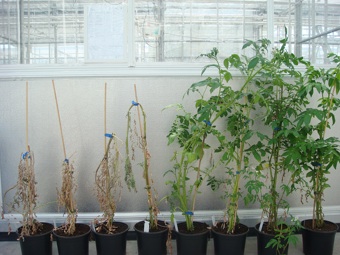
Features
Production
Research
Potatoes under dry conditions a real possibility
May 10, 2011 By Wageningen University
 May 10, 2011 – In the
May 10, 2011 – In the
future, plant breeders may be able to develop potato varieties that are better
able to withstand long drought spells than the currently grown varieties.
May 10, 2011 – In the
future, plant breeders may be able to develop potato varieties that are better
able to withstand long drought spells than the currently grown varieties.
This is the outcome of PhD
study carried out by Anitha Kumari in March 2011 at Wageningen University, part
of Wageningen UR. Kumari discovered huge differences in the ability of potato
plants to recover from drought spells. In addition, she also discovered one specific
region in the potato genome that harbors the genes that regulate the response
to drought of her potato plants.
 |
|
Potatoes use water very
efficiently. A potato plant produces more calories per litre of groundwater
than wheat, for example. However, tuber yield decreases rapidly when water is
scarce and plants suffer from drought. Kumari’s results indicate that it would
probably be feasible to develop potato plants that not only use water
efficiently, but that also recover well enough to produce high yields after a
drought spell.
The researcher from
Wageningen first carried out a large-scale study on the role of hereditary
traits of potato plants in response to drought.
For her research, Kumari
used a population derived from two potato plants with a diverse genetic
background, originating from two different wild potato species. She planted
this population in the greenhouse and left them without water for approximately
three weeks to induce drought stress. After rewatering, some of the potato
plants recovered well, while others died. This demonstrates that traits that
can enhance drought tolerance are available in this population, which can be
utilized to develop potatoes that are more tolerant to drought spells.
In her study, Kumari
investigated whether the genes in the potato plants had an increased or
decreased activity at the beginning of the dry spell. She discovered that more
than a thousand genes specifically responded to the dry conditions.
Genetic analysis of the
potato plants demonstrated that the differences in the activity of many of
these genes rely on one specific area in the DNA of the investigated potatoes.
This regulatory region was only active under drought, and not under normal
conditions, which led her to conclude that a major controller of the plants’
early response to drought is probably located within this region of the DNA.
Print this page